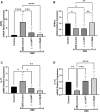SlpB Protein Enhances the Probiotic Potential of L. lactis NCDO 2118 in Colitis Mice Model
- PMID: 34987390
- PMCID: PMC8721164
- DOI: 10.3389/fphar.2021.755825
SlpB Protein Enhances the Probiotic Potential of L. lactis NCDO 2118 in Colitis Mice Model
Abstract
Bacteria used in the production of fermented food products have been investigated for their potential role as modulators of inflammation in gastrointestinal tract disorders such as inflammatory bowel diseases (IBD) that cause irreversible changes in the structure and function of gut tissues. Ulcerative colitis (UC) is the most prevalent IBD in the population of Western countries, and it is marked by symptoms such as weight loss, rectal bleeding, diarrhea, shortening of the colon, and destruction of the epithelial layer. The strain Propionibacterium freudenreichii CIRM-BIA 129 recently revealed promising immunomodulatory properties that greatly rely on surface-layer proteins (Slp), notably SlpB. We, thus, cloned the sequence encoding the SlpB protein into the pXIES-SEC expression and secretion vector, and expressed the propionibacterial protein in the lactic acid bacterium Lactococcus lactis NCDO 2118. The probiotic potential of L. lactis NCDO 2118 harboring pXIES-SEC:slpB (L. lactis-SlpB) was evaluated in a UC-mice model induced by Dextran Sulfate Sodium (DSS). During colitis induction, mice receiving L. lactis-SlpB exhibited reduced severity of colitis, with lower weight loss, lower disease activity index, limited shortening of the colon length, and reduced histopathological score, with significant differences, compared with the DSS group and the group treated with L. lactis NCDO 2118 wild-type strain. Moreover, L. lactis-SlpB administration increased the expression of genes encoding tight junction proteins zo-1, cln-1, cln-5, ocln, and muc-2 in the colon, increased IL-10 and TGF-β, and decreased IL-17, TNF-α, and IL-12 cytokines in the colon. Therefore, this work demonstrates that SlpB recombinant protein is able to increase the probiotic potential of the L. lactis strain to alleviate DSS-induced colitis in mice. This opens perspectives for the development of new approaches to enhance the probiotic potential of strains by the addition of SlpB protein.
Keywords: Lactococcus lactis; SlpB; colitis; inflammatory bowel disease; propionibacterium.
Copyright © 2021 Belo, Cordeiro, Oliveira, Braga, da Silva, Costa, Martins, Jan, Le Loir, Gala-García, Ferreira, Azevedo and do Carmo.
Conflict of interest statement
The authors declare that the research was conducted in the absence of any commercial or financial relationships that could be construed as a potential conflict of interest. The handling editor declared a past co-authorship with one of the authors (VACA).
Figures







References
-
- Abrantes F. A., Nascimento B. B., Andrade M. E. R., de Barros P. A. V., Cartelle C. T., Martins F. S., et al. (2020). Treatment with Bifidobacterium Longum 51A Attenuates Intestinal Damage and Inflammatory Response in Experimental Colitis. Benef. Microbes 11, 47–57. 10.3920/BM2019.0098 - DOI - PubMed
-
- Cai Z., Xu P., Wu Z., Pan D. (2018). Anti-inflammatory Activity of Surface Layer Protein SlpA of Lactobacillus Acidophilus CICC 6074 in LPS-Induced RAW 264.7 Cells and DSS-Induced Mice Colitis. J. Funct. Foods 51, 16–27. 10.1016/j.jff.2018.10.008 - DOI
-
- Carvalho R. D. O., do Carmo F. L. R., de Oliveira Junior A., Langella P., Chatel J. M., Bermúdez-Humarán L. G., et al. (2017). Use of Wild Type or Recombinant Lactic Acid Bacteria as an Alternative Treatment for Gastrointestinal Inflammatory Diseases: A Focus on Inflammatory Bowel Diseases and Mucositis. Front. Microbiol. 8, 800–813. 10.3389/fmicb.2017.00800 - DOI - PMC - PubMed
-
- Cooper H. S., Murthy S. N., Shah R. S., Sedergran D. J. (1993). Clinicopathologic Study of Dextran Sulfate Sodium Experimental Murine Colitis. Lab. Invest. 69, 238–249. - PubMed
LinkOut - more resources
Full Text Sources
Miscellaneous

